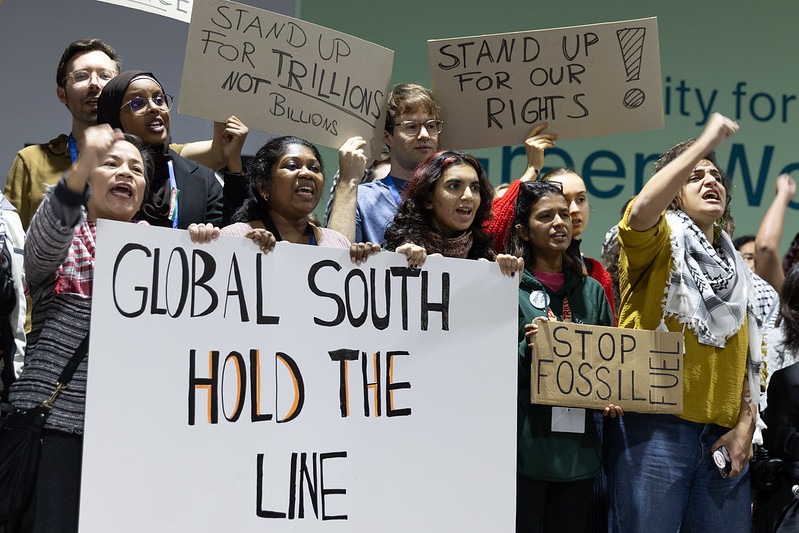As the final gavel came down at 5.30am on Sunday morning, the COP29 UN climate change conference in Baku closed with many unsettled grievances and some ruffled feathers.
From the controversial new climate finance goal, to the adoption of rules for a global carbon market and stalled efforts on cutting planet-heating emissions, the summit’s outcomes were contested and widely seen as inadequate to tackle the urgency of the climate crisis.
The finance deal was hailed as “the start of a new era on climate finance” by the EU’s climate commissioner, but condemned as a “joke” by Nigeria – and India rejected it fiercely as being “too little, too late”.
Climate Home News unpacks COP29’s successes and failures, most of which require further work next year on the path to COP30 in Brazil.
New climate finance goal
Tagged the “Finance COP”, all eyes in Baku were on negotiations towards a new collective quantified goal (NCQG) for climate finance to kick in from 2026. The final deal for wealthy governments to channel at least $300 billion a year by 2035 to developing countries replaced the previous $100-billion annual target set in 2009 for the 2020-2025 period.
From the very beginning, developed countries were strategically silent, as they avoided revealing the amount of finance – or “quantum” – they would be prepared to offer for the new target. Developing-country asks ranged from $440 billion, $600 billion and $900 billion of government finance per year. They proposed an overall target of $1.3 trillion which would include private finance mobilised by governments, but not market-rate loans, export credits or private investment in general.
As negotiations moved into the second week and towards the final days, developing countries became impatient with the lack of clarity. As whispers of a number ranging from $200bn-$300bn spread through the conference, Bolivian negotiator Diego Pacheco labelled the $200bn figure “a joke” during a press conference in the sidelines of COP29.
Reaching an agreement at #COP29 was essential to keep the 1.5°C global warming limit alive.
I had hoped for a more ambitious outcome – on both finance & mitigation – to meet the scale of the great challenge we face, but the agreement reached provides a base on which to build.…
— António Guterres (@antonioguterres) November 23, 2024
On Friday, the last official day of the conference, a number was finally put on the table by the COP29 presidency, suggesting $250bn a year – to the disappointment of developing countries. The African Group’s lead negotiator Ali Mohamed said this was “totally unacceptable”.
The talks took a further dramatic turn on Saturday when governments received a draft text containing a slightly higher offer of $300bn a year for the core government-led finance goal. This and other issues infuriated the Least Developed Countries (LDCs) and Small Island Developing States (SIDS), who stormed out of the negotiations in protest just hours before the closing plenary.
Namibia uses COP29 climate summit to push for oil and gas investments
After LDCs and SIDs won some concessions – but not on the size of the goal – the presidency gavelled through the deal pledging at least $300 billion a year by 2035, with developed countries “taking the lead” on providing it. The text says the money will come “from a wide variety of sources, public and private, bilateral and multilateral, including alternative sources”.
The existing $100bn goal includes direct government finance, a proportion of the public funding that flows through multilateral development banks (MDBs) and private finance “mobilised” by government money and export credits. It is unclear if the $300bn covers the same elements or more, experts said.
Under the $100bn goal, only 70% of MDB climate finance is counted, which excludes the share contributed by large emerging economies like China, India and Brazil.
But to the anger of some developing countries – especially India – the new goal recognises “the voluntary intention” of governments “to count all climate-related outflows from and climate-related finance mobilized by multilateral development banks towards achievement of the goal”.
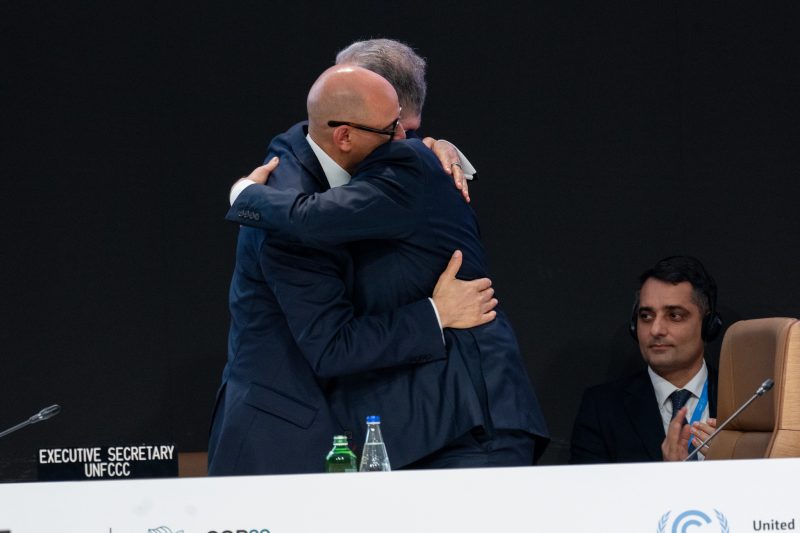
UN climate chief Simon Stiell hugs COP29 president Mukhtar Babayev at the closing plenary in Baku, Azerbaijan. (Photo: UNFCCC)
SIDS finance negotiator Michai Robertson told Climate Home that how MDB finance is counted and which private sources would be included in the $300bn will only be decided by the UNFCCC’s Standing Committe on Finance when countries report the first post-2025 figures, which will not be until 2028.
Fractious COP29 lands $300bn climate finance goal, dashing hopes of the poorest
A larger target of $1.3 trillion a year by 2035 was also set in Baku to scale up all sources of spending to combat climate change, including private investments in the Global South that are not linked to governments. How this broader target will be reached is uncertain, and will be discussed in the coming year under a “Baku to Belem Roadmap to 1.3T”.
The roadmap will look into “grants, concessional and non debt-creating instruments, and measures to create fiscal space” and produce a report by COP30 next year in Belem. It was first announced at a press conference in Baku by ministers from Colombia, Kenya, Barbados, Honduras and Panama. Barbados’ minister said it would consider measures such as redirecting fossil fuel subsidies in rich countries to climate action in the Global South.
SIDS negotiator Robertson criticised the roadmap as “a lot of smoke and mirrors”, adding that it was unclear how it would work.
Meanwhile the new finance goal also “encourages” developing countries to make contributions to climate finance “on a voluntary basis”, which they were not requested to do for the existing $100bn goal. While no countries are specified, the rich donor governments that pushed for this have said they want wealthier developing countries like China, Saudi Arabia and other Gulf states to chip in.
Cutting greenhouse gas emissions
Last year at COP28 in the UAE, countries completed the first global review of climate policies under the 2015 Paris Agreement – a process known as the global stocktake (GST). Among other things, last year’s deal saw countries commit to triple renewable energy capacity by 2030 and “transition away” from fossil fuels in energy systems in a fair manner to achieve the goals of the Paris pact, including limiting global warming to “well below” 2C and ideally to 1.5C.
In Baku, countries were meant to launch the “UAE Dialogue” to work out how to implement the recommendations from the GST and inform the upcoming round of new and stronger national climate plans – known as nationally determined contributions (NDCs) – due in 2025.
However, at COP29 countries did not reach consensus on advancing the UAE Dialogue, after Saudi Arabia blocked any references to fossil fuels in the text, in what observers described as “destructive” opposition.
Governments were also split on whether the UAE Dialogue should address issues beyond financing the commitments made at COP28, which Saudi negotiators claimed was the main scope of the dialogue. They used this as an excuse to avoid discussions on the energy transition.
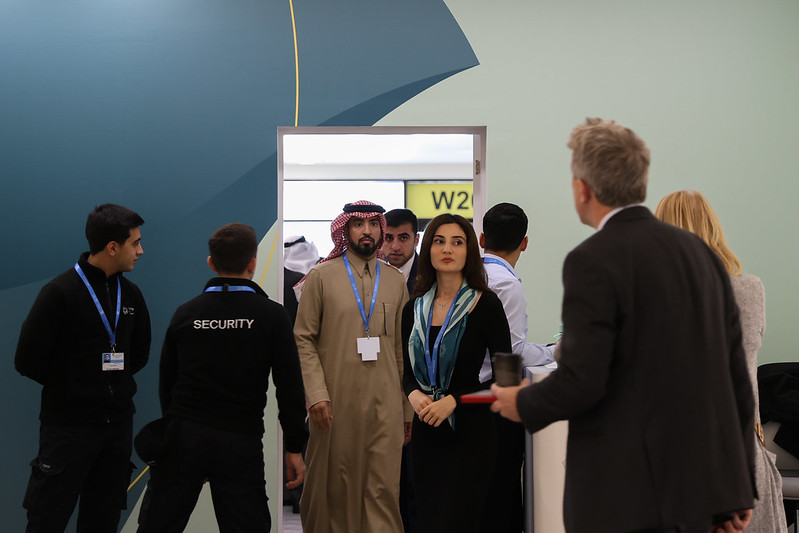
Negotiators in the hallways of COP29 in Baku, Azerbaijan. (Photo: UNFCCC)
A watered-down draft text proposed to “reaffirm” last year’s pledge without calling out fossil fuels by name, and also emphasised the role of “transitional fuels” – which could be interpreted to mean fossil gas.
Latin American countries, developed countries and small islands opposed this text, meaning that the talks on the dialogue had to be pushed to June 2025, aiming for a new outcome at COP30 next November.
Without a deal in Baku, countries missed the chance to adopt two new targets viewed as key for the energy transition: one aiming to increase energy storage capacity to 1,500 gigawatts by 2030 and another pledging to add 25 million kilometres of power grids by 2030.
In a different strand of the talks – a “non-prescriptive” effort to enhance emissions reductions known as the Mitigation Work Programme (MWP) – countries approved a weak text after Saudi negotiators almost managed to collapse talks on it earlier in the summit, causing the COP29 presidency to step in and revive them.
All mentions of fossil fuels were removed from the MWP, as well as any mention of COP28’s pledges to reverse deforestation by 2030, phase out fossil fuel subsidies and triple renewables by 2030.
The outcome frustrated developed countries which said the text failed to send strong signals for ambitious NDCs next year. Germany’s climate envoy Jennifer Morgan called the MWP decision a “big step back”.
Just transition
Countries also failed to reach an agreement on the just transition work programme (JTWP) at COP29 – a deal meant to support workers and communities affected by the transition away from fossil fuels towards cleaner energy.
Governments were divided on issues of human and labour rights, measures seen as restricting free trade, adaptation and emissions reductions. A major bone of contention was whether to designate finance to support plans for a just transition.
Fatuma Hussein, Africa’s lead negotiator on just transition, told Climate Home that developed countries wanted to keep discussions focused on “national dimensions” rather than what needs to be done internationally to enable just transition on a global scale. She added that the lack of finance was “the biggest departure point” causing developing countries to reject the draft text.
Negotiations on this issue fell down the COP29 presidency’s list of priorities as the finance talks became heated. It set up a last-minute contact group and presented a final draft to save the JTWP, but no agreement was reached. Talks will continue in June next year, with international trade unions expressing their concern over the lack of a decision on next steps in Baku.
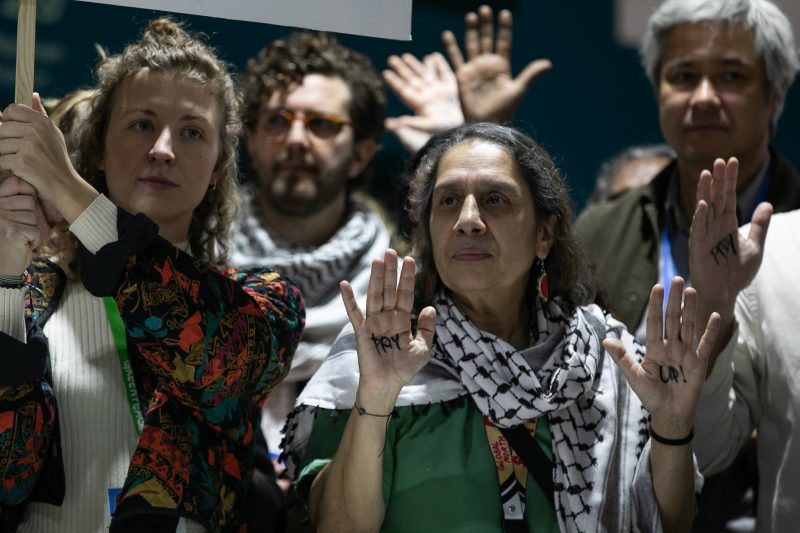
Activists calling for “trillions” in climate finance at COP29 in Baku, Azerbaijan. (Photo: UNFCCC)
Global goal on adaptation
Work on the global goal on adaptation (GGA) – which is enshrined in the Paris Agreement but has yet to be implemented – made little progress during most of COP29, due to a lack of consensus on the means of implementation, generally understood to mean finance. In the end, a procedure to move the goal forward was agreed, called the Baku Adaptation Road Map.
Unwillingness from developed countries to put money on the table, as well as the difficulty of selecting indicators to measure progress, held back the talks at COP29, experts told Climate Home.
The GGA was adopted in 2015 with a view to enhancing resilience to climate change impacts, but countries defined a set of guidelines for it only last year, known as the UAE Framework. In Baku, countries were meant to advance on identifying indicators to measure progress, under a process known as the UAE-Belém Work Programme, which is due to be finalised next year at COP30.
However, in addition to the contention around finance, the role of transformational adaptation – meaning deep, long-term societal changes that influence sustainable development – was another obstacle to progress, as some developing countries like Senegal kicked back against it, saying it could throw up new barriers in accessing finance.
In the second week of COP29, countries agreed to defer a review of the GGA framework until after the second global stocktake in 2028. But the Baku Adaptation Road Map was launched to enable talks to continue in 2025.
Richard Klein, a senior researcher on adaptation at the Stockholm Environment Institute, told Climate Home that the GGA did not take substantive steps forward at COP29, further delaying implementation. Meanwhile, he said, “the gap between the adaptation action needed and what is being implemented continues to widen.”
India fires warning shot with rejection of finance deal at COP29
Gender work programme
This year, the main focus of the gender negotiations at the UN climate summit was the renewal of the Lima Work Programme (LWP), under which a Gender Action Plan is produced every five years – both of which establish guidelines for gender-responsive climate policies.
Some conservative countries, including the Vatican, Saudi Arabia and Egypt, successfully lobbied to remove some human rights-related language from the decision text on issues including diversity and intersectionality that had been being championed mainly by Latin American nations and the EU.
In the end, an agreement was reached, renewing the Lima Work Programme for another 10 years, with a review scheduled in five years, and a new gender action plan due to be drawn up in 2025.
Another topic of discussion was whether to house the LWP under the Paris Agreement or the UN climate convention. Some parties wanted it to be addressed in talks on both, but others argued that that would double the work. Countries decided to keep it just under the convention.
They also agreed to work on data that will be broken down by gender and age, gender-responsive implementation of just transitions, creating quality jobs for women that are aligned with national climate plans, and simplifying access to finance for grassroots women’s groups and Indigenous women.
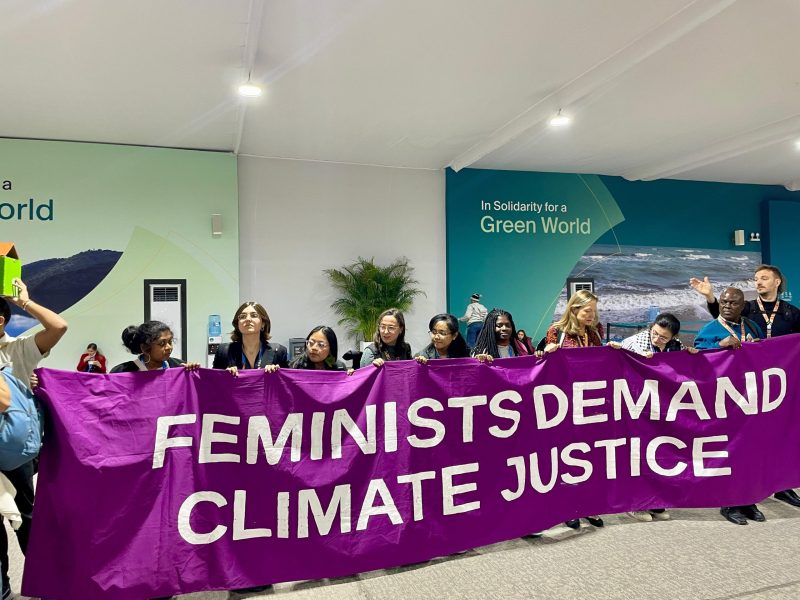
Feminists call for climate justice at the COP29 negotiations in Baku, Azerbaijan. (Photo: Mariel Lozada)
Carbon markets
At COP29, talks on setting up a new global carbon market made a significant breakthrough after nearly a decade of discussions, as countries agreed on a package of rules under the Paris Agreement’s “Article 6”.
On the first day of the Baku summit, the COP29 presidency scored an early win as countries approved guidelines laying the foundations for a regime to develop and trade carbon credits. This agreement was hailed by COP29 President Mukhtar Babayev as a “breakthrough” that “achieves full operationalisation of Article 6” – but experts criticised the procedure that was followed.
After failing to secure agreement in previous years, the rules were eventually crafted by a technical committee and then presented to governments at COP29.
With approval of the rules on Article 6.2, which regulates bilateral emissions trading between countries, and 6.4, which sets up an international carbon market, countries will now finalise technical details and could kick off the new markets from 2025.
But campaigners expressed concerns over the quality of the credits and how to deal with any problems. According to Carbon Market Watch, the rules agreed for Article 6.2 may not be strong enough to ensure real emissions reductions, as trades require less immediate transparency. Key technical information is not required to be disclosed until after trades have already happened, which could take years, the NGO warned.
The first batch of credits to be traded under the new Paris market is likely to consist of old offsets originally developed under the Kyoto Protocol-era’s Clean Development Mechanism (CDM), many of which were regarded as delivering little concrete benefit for the climate.
(Reporting by Vivian Chime, Mariel Lozada and Joe Lo; editing by Sebastian Rodriguez, Joe Lo and Megan Rowling)
